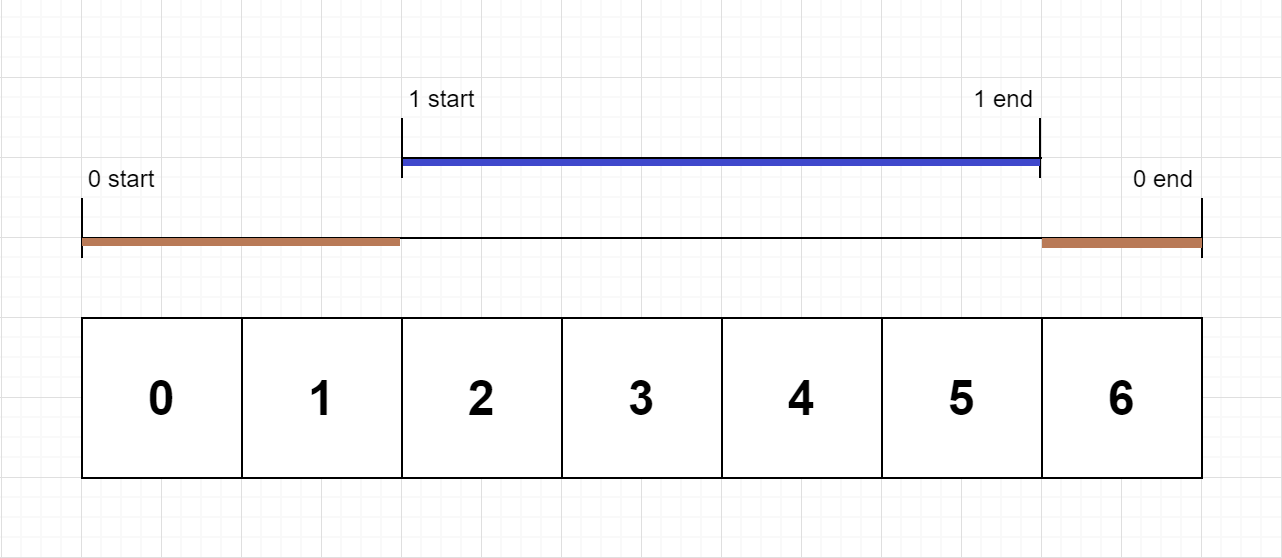| comments | difficulty | edit_url | tags | ||
|---|---|---|---|---|---|
true |
中等 |
|
有一个 单线程 CPU 正在运行一个含有 n 道函数的程序。每道函数都有一个位于 0 和 n-1 之间的唯一标识符。
函数调用 存储在一个 调用栈 上 :当一个函数调用开始时,它的标识符将会推入栈中。而当一个函数调用结束时,它的标识符将会从栈中弹出。标识符位于栈顶的函数是 当前正在执行的函数 。每当一个函数开始或者结束时,将会记录一条日志,包括函数标识符、是开始还是结束、以及相应的时间戳。
给你一个由日志组成的列表 logs ,其中 logs[i] 表示第 i 条日志消息,该消息是一个按 "{function_id}:{"start" | "end"}:{timestamp}" 进行格式化的字符串。例如,"0:start:3" 意味着标识符为 0 的函数调用在时间戳 3 的 起始开始执行 ;而 "1:end:2" 意味着标识符为 1 的函数调用在时间戳 2 的 末尾结束执行。注意,函数可以 调用多次,可能存在递归调用 。
函数的 独占时间 定义是在这个函数在程序所有函数调用中执行时间的总和,调用其他函数花费的时间不算该函数的独占时间。例如,如果一个函数被调用两次,一次调用执行 2 单位时间,另一次调用执行 1 单位时间,那么该函数的 独占时间 为 2 + 1 = 3 。
以数组形式返回每个函数的 独占时间 ,其中第 i 个下标对应的值表示标识符 i 的函数的独占时间。
示例 1:
输入:n = 2, logs = ["0:start:0","1:start:2","1:end:5","0:end:6"] 输出:[3,4] 解释: 函数 0 在时间戳 0 的起始开始执行,执行 2 个单位时间,于时间戳 1 的末尾结束执行。 函数 1 在时间戳 2 的起始开始执行,执行 4 个单位时间,于时间戳 5 的末尾结束执行。 函数 0 在时间戳 6 的开始恢复执行,执行 1 个单位时间。 所以函数 0 总共执行 2 + 1 = 3 个单位时间,函数 1 总共执行 4 个单位时间。
示例 2:
输入:n = 1, logs = ["0:start:0","0:start:2","0:end:5","0:start:6","0:end:6","0:end:7"] 输出:[8] 解释: 函数 0 在时间戳 0 的起始开始执行,执行 2 个单位时间,并递归调用它自身。 函数 0(递归调用)在时间戳 2 的起始开始执行,执行 4 个单位时间。 函数 0(初始调用)恢复执行,并立刻再次调用它自身。 函数 0(第二次递归调用)在时间戳 6 的起始开始执行,执行 1 个单位时间。 函数 0(初始调用)在时间戳 7 的起始恢复执行,执行 1 个单位时间。 所以函数 0 总共执行 2 + 4 + 1 + 1 = 8 个单位时间。
示例 3:
输入:n = 2, logs = ["0:start:0","0:start:2","0:end:5","1:start:6","1:end:6","0:end:7"] 输出:[7,1] 解释: 函数 0 在时间戳 0 的起始开始执行,执行 2 个单位时间,并递归调用它自身。 函数 0(递归调用)在时间戳 2 的起始开始执行,执行 4 个单位时间。 函数 0(初始调用)恢复执行,并立刻调用函数 1 。 函数 1在时间戳 6 的起始开始执行,执行 1 个单位时间,于时间戳 6 的末尾结束执行。 函数 0(初始调用)在时间戳 7 的起始恢复执行,执行 1 个单位时间,于时间戳 7 的末尾结束执行。 所以函数 0 总共执行 2 + 4 + 1 = 7 个单位时间,函数 1 总共执行 1 个单位时间。
提示:
1 <= n <= 1001 <= logs.length <= 5000 <= function_id < n0 <= timestamp <= 109- 两个开始事件不会在同一时间戳发生
- 两个结束事件不会在同一时间戳发生
- 每道函数都有一个对应
"start"日志的"end"日志
我们定义一个栈
遍历日志数组,对于每一条日志,我们首先将其按照冒号分隔,得到函数标识符
如果
最后返回数组
时间复杂度
class Solution:
def exclusiveTime(self, n: int, logs: List[str]) -> List[int]:
stk = []
ans = [0] * n
pre = 0
for log in logs:
i, op, t = log.split(":")
i, cur = int(i), int(t)
if op[0] == "s":
if stk:
ans[stk[-1]] += cur - pre
stk.append(i)
pre = cur
else:
ans[stk.pop()] += cur - pre + 1
pre = cur + 1
return ansclass Solution {
public int[] exclusiveTime(int n, List<String> logs) {
int[] ans = new int[n];
Deque<Integer> stk = new ArrayDeque<>();
int pre = 0;
for (var log : logs) {
var parts = log.split(":");
int i = Integer.parseInt(parts[0]);
int cur = Integer.parseInt(parts[2]);
if (parts[1].charAt(0) == 's') {
if (!stk.isEmpty()) {
ans[stk.peek()] += cur - pre;
}
stk.push(i);
pre = cur;
} else {
ans[stk.pop()] += cur - pre + 1;
pre = cur + 1;
}
}
return ans;
}
}class Solution {
public:
vector<int> exclusiveTime(int n, vector<string>& logs) {
vector<int> ans(n);
stack<int> stk;
int pre = 0;
for (const auto& log : logs) {
int i, cur;
char c[10];
sscanf(log.c_str(), "%d:%[^:]:%d", &i, c, &cur);
if (c[0] == 's') {
if (stk.size()) {
ans[stk.top()] += cur - pre;
}
stk.push(i);
pre = cur;
} else {
ans[stk.top()] += cur - pre + 1;
stk.pop();
pre = cur + 1;
}
}
return ans;
}
};func exclusiveTime(n int, logs []string) []int {
ans := make([]int, n)
stk := []int{}
pre := 0
for _, log := range logs {
parts := strings.Split(log, ":")
i, _ := strconv.Atoi(parts[0])
cur, _ := strconv.Atoi(parts[2])
if parts[1][0] == 's' {
if len(stk) > 0 {
ans[stk[len(stk)-1]] += cur - pre
}
stk = append(stk, i)
pre = cur
} else {
ans[stk[len(stk)-1]] += cur - pre + 1
stk = stk[:len(stk)-1]
pre = cur + 1
}
}
return ans
}function exclusiveTime(n: number, logs: string[]): number[] {
const ans: number[] = Array(n).fill(0);
let pre = 0;
const stk: number[] = [];
for (const log of logs) {
const [i, op, cur] = log.split(':');
if (op[0] === 's') {
if (stk.length) {
ans[stk.at(-1)!] += +cur - pre;
}
stk.push(+i);
pre = +cur;
} else {
ans[stk.pop()!] += +cur - pre + 1;
pre = +cur + 1;
}
}
return ans;
}